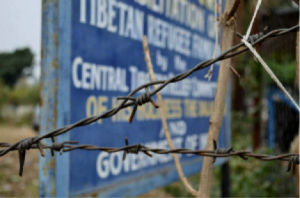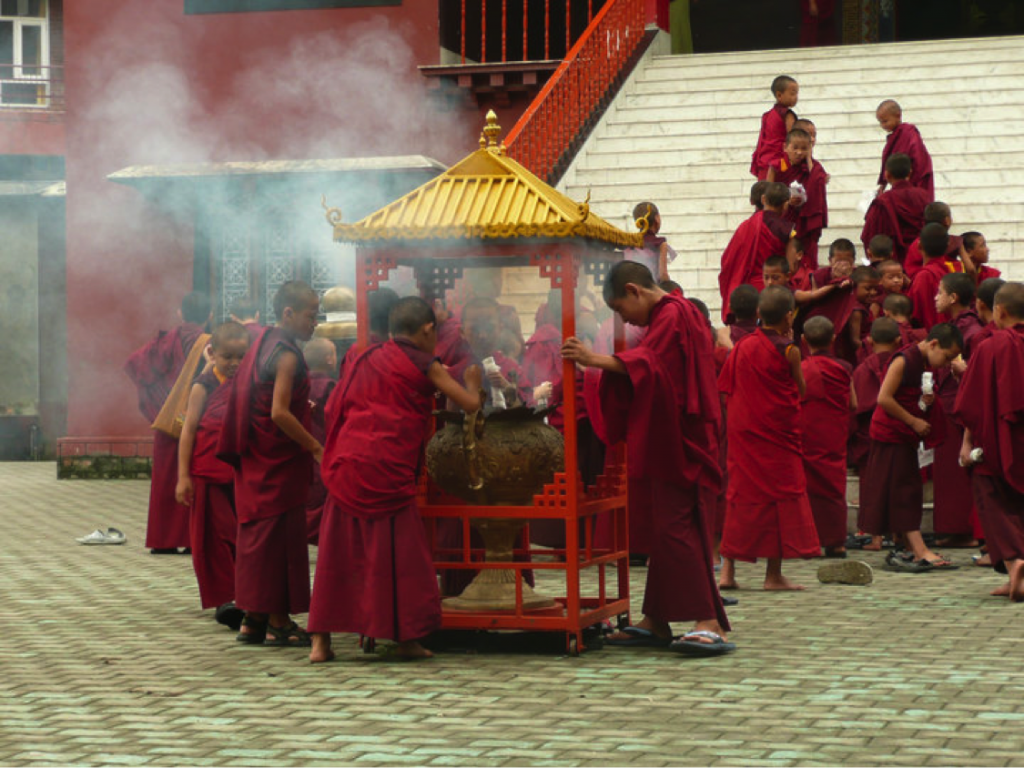This post is part of the joint blog series on ‘Gender and Migration’ co-hosted by Border Criminologies and COMPAS. Posts in this series will be published on both blogs every Friday until the end of June.
 There are a multitude of individual realities that exist at borders and within borderlands that are often neglected in contemporary border studies. After listening to the stories of Tibetan refugees living in India, it was evident that there are complex social, political and religious factors that exist within the Tibetan borderlands that have been ignored. While the way we navigate borders in their physical form has become an increasingly critical component of criminological research over the last decade, the pace at which social, political and cultural contexts change means that borders are constantly evolving and creating different challenges for different people. Tibetan border crossings present a platform to begin to investigate these challenges, and at the same time, explore the border realities of a migrant population that to date remains undocumented in critical criminology. In light of this, this post presents some of my initial observations of the interactions between Tibetan women and the border, with a particular focus on the non-physical border constructs and the role gender plays in the navigation of these borders.
There are a multitude of individual realities that exist at borders and within borderlands that are often neglected in contemporary border studies. After listening to the stories of Tibetan refugees living in India, it was evident that there are complex social, political and religious factors that exist within the Tibetan borderlands that have been ignored. While the way we navigate borders in their physical form has become an increasingly critical component of criminological research over the last decade, the pace at which social, political and cultural contexts change means that borders are constantly evolving and creating different challenges for different people. Tibetan border crossings present a platform to begin to investigate these challenges, and at the same time, explore the border realities of a migrant population that to date remains undocumented in critical criminology. In light of this, this post presents some of my initial observations of the interactions between Tibetan women and the border, with a particular focus on the non-physical border constructs and the role gender plays in the navigation of these borders.
The Borders Inside Tibet
Through my research into Tibetan border crossings, it’s become evident that both Tibetan women and nuns navigate more than just the physical manifestation of the border. As Tibet continues to move into the ‘modern’ world, Tibetan women and nuns have found themselves at the border between their traditional cultural identities, and the identity that’s dictated by the socialist policies of the People’s Republic of China. Nuns also have to navigate traditional gender expectations associated with preserving the Tibetan culture and pursuing a monastic education.
One of the biggest assaults on Tibet during the Cultural Revolution was the dissolution of gender boundaries through the integration of the monastic and lay communities, as described by Charlene Makley. In pre-1950s Tibet, traditional Buddhist society structures deemed the Buddhist nuns as a third gender, which determined their place in the monastic community and changed what would have been the traditional social passage, which largely ended in marriage. Following the Communist occupation, the clear gender structures within the Tibetan community became blurred. The social expectations of women shifted, leading to what has been referred to as ‘communist androgyny.’ Women were moved from traditional household lifestyles into the political sphere, despite being historically reserved for men and monks. Tibetan nuns were removed from the nunneries, returned home and forced to marry. In prisons, nuns became what Robert Barnett described as a ‘site of performance,’ whereby Chinese officials played out their authority by forbidding the nuns to cut their hair―a rule not applied to other women in the prison, or to women anywhere else in the world. The gender confusion was carried into the post-Moaist Tibet, where women in the public sphere and nuns became a ‘site of resistance’ in the revival of traditional Tibetan culture and social structures.
 Many issues inside Tibet appear to be largely void of such gendered bias. It’s well documented that since the Chinese occupation in the 1950s, Tibetans have been subject to social and political oppression, forced population displacement, police violence, mass arrests and torture. Despite the efforts of advocates to portray these experiences as collective, historical accounts, indicate that women were often subject to more severe punishments in prisons. In his research into the experience of nuns in the Drapchi Prison, Steven Marshall highlighted that ‘sense organs, such as tongue and ears, body cavities and sexual areas, especially on females, have been routine points of application for electric shocks.’ This isn’t to suggest that men and monks during the Chinese occupation weren’t also subject to severe abuses, nor were they immune from similar cultural and social borders. Rather, these experiences provide the impetus to look further into how gender plays into the various ways internal, external, physical and non-physical borders are navigated, and how the experience of gender can manifest as a driver of migration.
Many issues inside Tibet appear to be largely void of such gendered bias. It’s well documented that since the Chinese occupation in the 1950s, Tibetans have been subject to social and political oppression, forced population displacement, police violence, mass arrests and torture. Despite the efforts of advocates to portray these experiences as collective, historical accounts, indicate that women were often subject to more severe punishments in prisons. In his research into the experience of nuns in the Drapchi Prison, Steven Marshall highlighted that ‘sense organs, such as tongue and ears, body cavities and sexual areas, especially on females, have been routine points of application for electric shocks.’ This isn’t to suggest that men and monks during the Chinese occupation weren’t also subject to severe abuses, nor were they immune from similar cultural and social borders. Rather, these experiences provide the impetus to look further into how gender plays into the various ways internal, external, physical and non-physical borders are navigated, and how the experience of gender can manifest as a driver of migration.
The Border Around Tibet
Conversations I’ve had with Tibetan refugees in India reveal that as with other refugee flows in the global south, human rights is the predominant motive. However, we know very little about border realities in this region or narratives of persecution, particularly among women and nuns in Tibet. Determining how gender interacts with border crossings is complex, as there are cultural, political and religious factors that result in gender playing out in other ways. I explore how gender is performed―or not performed―in the way individual women and nuns told their border crossing stories.
It could be argued that the manipulation of the gender structures in Tibet has resulted in women shifting their individual narratives to a non-gendered, ‘Tibetan’ narrative that is historically, culturally and politically aligned with the goals of the Tibetan government in exile. It became evident after hearing the stories of Tibetan women, that gender manifests as secondary to being Tibetan. Robert Barnett’s examination of women and politics in contemporary Tibet described this situation:
…she stands accused of fabricating her claim to have lived in Tibet, or even to be Tibetan; if her story is found to be false, she faced deportation. Apart from her memories and her papers it is only her body that now remains to represent what is Tibetan about her, and it is not believed. She resists the accusation of deception by what we might call ‘performing her nation’, in this case by presenting a narrative that establishes her as part of the extended Tibetan body politic and identifies herself within a history of nationality oppression and resistance.
Instead of presenting herself as a woman subjected to political persecution, she chose to portray herself first and foremost as Tibetan. Similarly, where respondents discussed traumatic experiences with me, they switched between their individual experiences, to the broader experience of Tibetans. The majority of female respondents indicated they were subjected to some form of human rights abuse, often involving severe reporting measures that restricted their freedom of movement or intrusive surveillance of their religious and political activities. While sharing these stories, the women switched between their own personal experience and those of all Tibetans, often adopting historical narratives in describing their own experience. The interchange between the individual and collective narrative became a routine feature of these stories. However, when participants detailed their experience of more severe abuses―such as being beaten or tortured in prison―the narrative remained individualised, yet void of detail.
 The Tibetan Buddhists’ narrative differs due to the cultural acceptance of pain and suffering as a part of life. Tibetan Buddhists believe we exist in the realm of samsara―a ceaseless cycle of birth and death. The only way to reach liberation and enlightenment involves acceptance of pain and suffering for wrongdoings in a previous life. All nuns who participated in this research noted they were not in any pain as a result of their suffering in Tibet, and even though their experience drove them from Tibet, they were happy. This acceptance of pain and suffering was further illustrated through the efforts to diminish the severity of their own experiences of torture by suggesting the experience of others, particularly the Dalai Lama, were worse. The way nuns transferred the conversation about the severity of their experience to others is a culturally specific coping mechanism influenced by the practice of Buddhism.
The Tibetan Buddhists’ narrative differs due to the cultural acceptance of pain and suffering as a part of life. Tibetan Buddhists believe we exist in the realm of samsara―a ceaseless cycle of birth and death. The only way to reach liberation and enlightenment involves acceptance of pain and suffering for wrongdoings in a previous life. All nuns who participated in this research noted they were not in any pain as a result of their suffering in Tibet, and even though their experience drove them from Tibet, they were happy. This acceptance of pain and suffering was further illustrated through the efforts to diminish the severity of their own experiences of torture by suggesting the experience of others, particularly the Dalai Lama, were worse. The way nuns transferred the conversation about the severity of their experience to others is a culturally specific coping mechanism influenced by the practice of Buddhism.
The shift from the individual through to the collective presents many challenges in interpreting the individual experiences of human rights abuses. When gender is not examined as a driver of migration, or a culturally specific influence on an individual’s story, criminology is missing a unique interaction with the physical and non-physical dimensions of borders. When human rights abuses are identified as the key driver for migration, understanding the ways individuals experience that driver are difficult unless direct personal experiences are elicited. Although gender is explored here in a way that’s not necessarily a border crossing experience in itself, it sets a significant methodological and conceptual challenge as gender, like the experience of human rights abuses, is not always a personalised characteristic for individual stories.
Author affiliation: Bodean Hedwards, PhD student at Monash University, Australia
